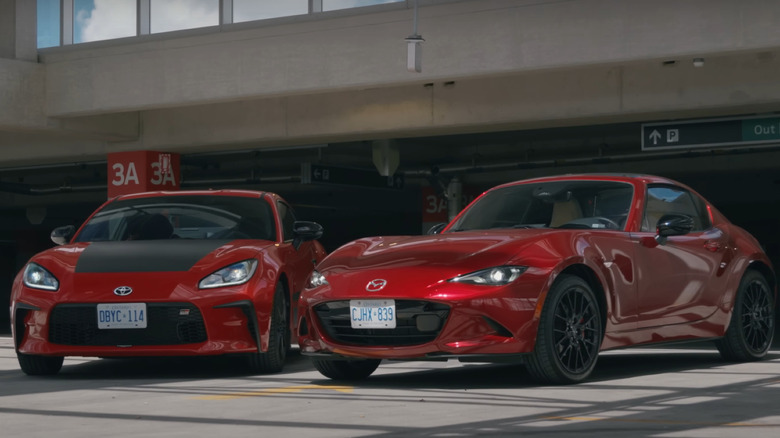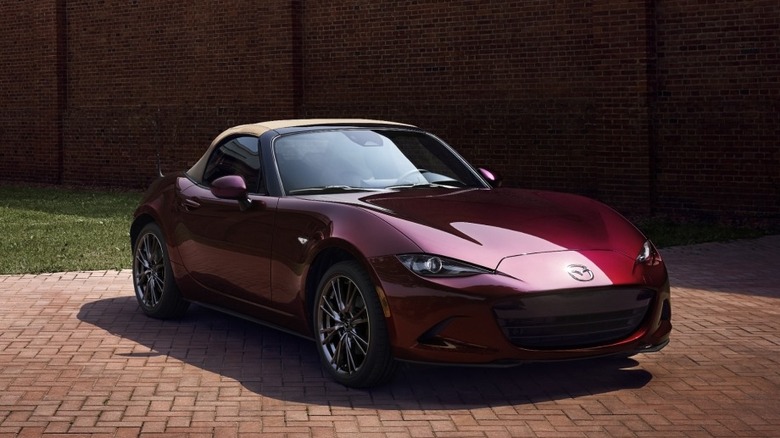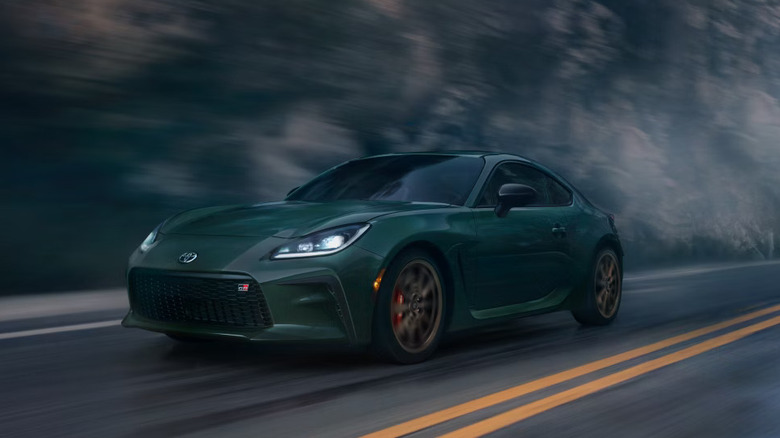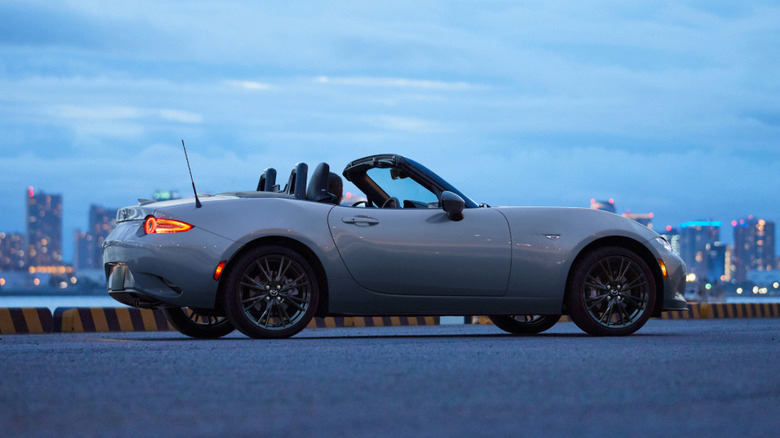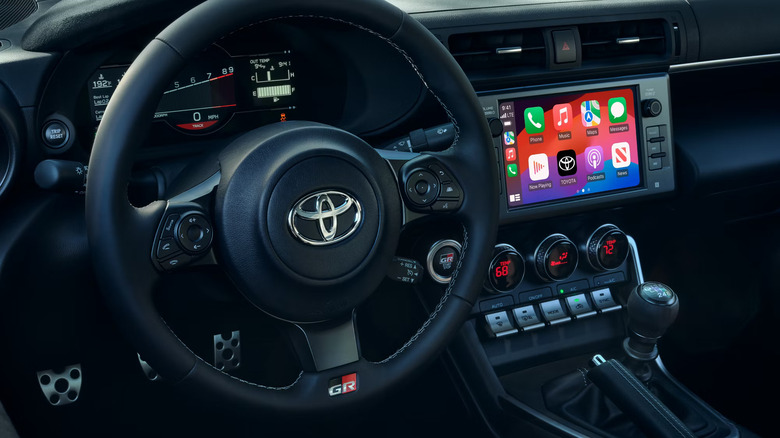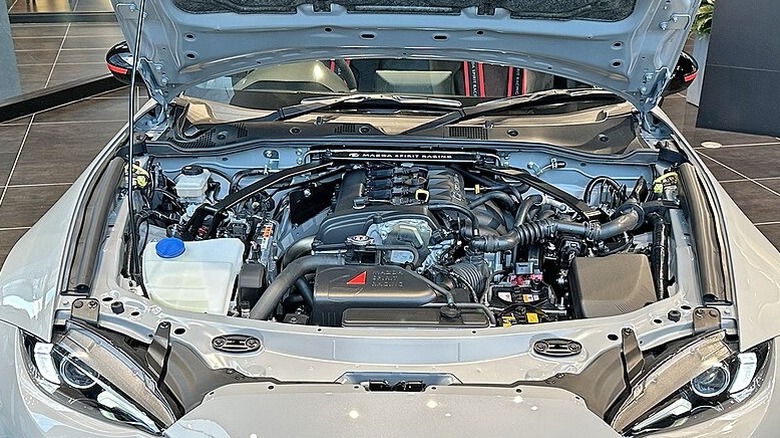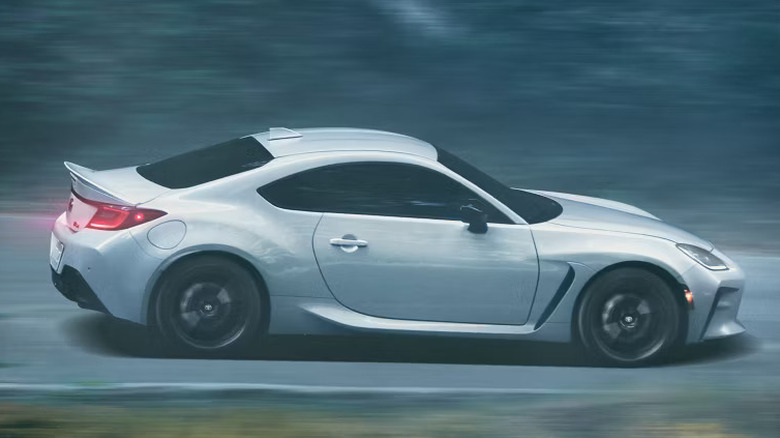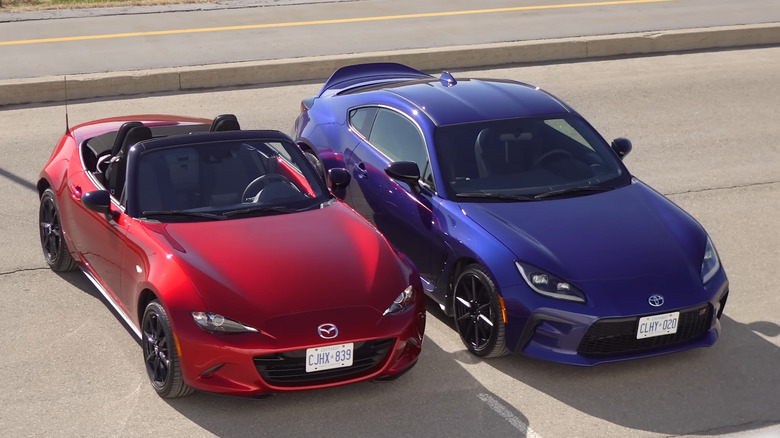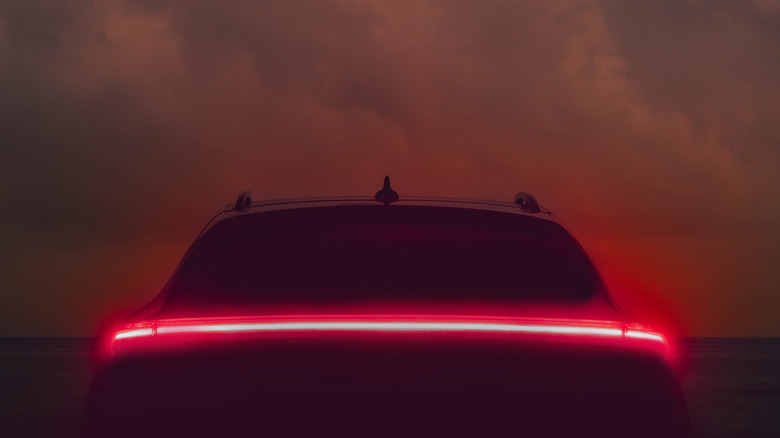Toyota GR86 Vs. Mazda MX-5 Miata: Which Sports Car Should You Get?
Something intriguing is happening in an often-overlooked corner of the automotive market. Recent headlines have trumpeted the triumph of the electric automobile, and the dominant design ethos trends toward the vaguely stylish SUV crossover. However, there's a holdover that harkens back to an era when imported rear-wheel-drive tuners delighted the masses.
In that market corner, perhaps a raceway, the Mazda MX-5 Miata and Toyota GR86 are, if not locked in fierce competition, certainly eyeing each other from across the starting line. They remain two survivors of a market once bustling with Nissan's capable Z-cars, Mazda's unconventional RX-7s, and a handful of other imported front-engine, rear-wheel-drive sports cars designed for the everyday driver. These vehicles were affordable and thrilling to drive for those unconcerned with car seats or the prospect of bringing along anyone other than a sweetheart.
Other contenders still exist in this segment. Nissan's Z has seen a price increase but continues to deliver strong performance, while Mazda's excellent MX-5 Miata maintains its sterling reputation as the king of accessible sports cars. Meanwhile, Toyota's relatively new Gazoo Racing division has generated buzz with several exciting models stamped with GR. And leading the charge is the GR86. Choosing a sports car is ultimately subjective, but we examine the history, specs, and features of the Mazda MX-5 Miata and Toyota GR86 to give you a glimpse of each.
Mazda Miata
The Miata ethos took root in 1989 and continues to captivate enthusiasts with its core tenets: lightweight, zippy, and fun. Whether it's a Florida holiday car, a cherished garage queen, or the star of a professional race team, the Miata's success is undeniable. The 35th Anniversary special edition, unveiled by Mazda for the 2025 model year, is a testament to this enduring legacy. Nameplates don't last nearly 40 years without some fire behind the smoke, and the Miata's flame still burns bright.
The Miata formula exemplifies the power of simplicity and competent execution. Its success is not driven by constant change but by a steadfast commitment to its core principles. The MX-5 has remained in its fourth generation since 2016, yet the question lingers: Are there young contenders ready to challenge the Miata's reign as the weekend roadster king? That's part of what we're here to find out.
The rest is how the Miata compares to the GR86 and the type of driver best suited to each. Other front-engine, rear-wheel-drive options exist, but as prices climb, these two remain among the most affordable and accessible. But that doesn't necessarily mean they are the same.
Toyota GR86
The Toyota GR86 is the Gen-Z upstart to the Miata's experienced millennial. A little less long in the tooth, disruptive when it wants to be, and perhaps not as set in its ways as the Mazda, Toyota Gazoo Racing is a relatively recent force in the auto performance industry, yet it has already churned out fascinating cars, including the 2025 Toyota GR Corolla and hot-hatch GR Yaris we wish were sold in the States. Make no mistake, the GR86 is neither a Corolla nor a Yaris, nor any other nameplate, unless you want to delve into yesteryear and pull up the Scion FR-S. That was a long time ago, and the GR86 is a different vehicle, one bearing Toyota's logo rather than Scion's, and perhaps even better, Gazoo Racing's.
The Toyota 86 arrived in 2017 as a Toyota-badged refresh of the FR-S. Developed in conjunction with the Subaru BRZ, Toyota adopted an interesting Subaru-esque trait: a 2.0-liter Boxer engine produced by Subaru's powertrain division. Nearly a decade later, the flat configuration presents interesting possibilities, offering a lower center of gravity and improved handling, albeit now with an increased displacement of 2.4 liters.
The engine is just the beginning. Toyota has been a byword for staid reliability for decades. What happens when Toyota focuses its refined processes through the precision lens of Gazoo Racing? The new GR86 is the best place to find out.
Overview
The Miata is a marvel of balance. With its 2,366-pound curb weight distributed 53% to the front and 47% to the rear of its 90.9-inch wheelbase, it stands as a testament to precision engineering. This classic yet spritely convertible, with its old-fashioned three-pedal six-speed, is a joy to drive, especially in the 30-80 mph range.
Pricing starts at $30,515 and increases to $42,285, depending on the trim. It remains within reach for many seeking a second car, because that's precisely what the Miata is. Few people live exclusively in a golf-and-grocery lifestyle where a small two-seater convertible is the optimal choice. The Miata has charm in spades, but it also offers space for just one passenger (if they're not too big), and depending on the size of the golf bags, a second trip might be necessary.
Toyota's GR86 presents a different facade. A 2+2 coupe with a pair of technically-there rear seats, it may not be an enormous functional upgrade from the Miata's pure sport persona, but it underscores a distinct vision from each automaker. The GR86 evokes the older sibling with cool friends and a cool car, while the Miata watches the young contender, shaking its head and thinking about track day. The GR86 slots neatly into the Miata's price range, with an anticipated $32,000 to $38,000 MSRP for the 2026 model.
Dimensions and interior
The headline of the Miata is that it is a two-seater, and a petite one at that. Its 90.9-inch wheelbase contributes to an overall length of 154.1 inches. That ain't much, and the snug cabin and meager 4.6 cubic feet of storage capacity reinforce the Miata's sporty role, translating to a svelte 2,366-pound curb weight. To its credit, Mazda has kept up with the competition in terms of technology and features. An 8.8-inch screen serves as the nerve center of an infotainment system, which, depending on the trim, features Bose speakers, Apple CarPlay, Android Auto, and Bluetooth. The interior design is classic, if you grew up when cars still had knobs and buttons. The screen dominates, but below, manual climate switches complement a classic analog dash display.
The GR86, in contrast, offers more space, being slightly longer than the Miata with an overall length of 167.9 inches and a 101.4-inch wheelbase. This extra space, along with the inclusion of a pair of rear seats, contributes to a tad more comfort and practicality, bringing the curb weight to 2,833 pounds. Inside, an 8-inch centrally mounted touchscreen provides drivers with access to Apple CarPlay and Android Auto, complemented by an eight-speaker sound system featuring an optional subwoofer. The dash display is digital but pleasing, with Track Mode bringing a linear tachometer front and center. The interior is futuristic without being busy, a nice blend of vintage and modern controls and aesthetics.
Trims
What does that range of cash get you at a Mazda dealership? The 2025 Miata comes in three trims: $29,530 Sport, $33,030 Club, and $34,830 Grand Touring. There's also a special 35th Anniversary edition available at $36,250. The most important thing to note is that those trims do not include engine options. Every Miata gets the same engine, which we'll cover below, and a six-speed manual, which can be swapped for a six-speed automatic with paddle shifters, but only in GT trim. All models feature modern driver aids, including Blind Spot Monitoring, Lane Departure Warning, and Stability Control. The trim levels differentiate comfort and convenience features. Bose speakers appear on the Club model, along with Apple CarPlay, Android Auto, and a limited-slip differential.
Toyota also offers the GR86 at three trim levels: $30,000 GR86, $32,600 GR86 Premium, and $35,270 GR86 Hakone Edition. Similar to the Miata, the GR86 offers no engine choice. The difference in price comes down to practical and aesthetic additions like alloy wheels, premium tires, and other accoutrements, features you'll be glad you ordered when you run into Dom Toretto.
Engine
The Mazda produces 181 horsepower and 151 lb-ft of torque via its Skyactiv-G 2.0-liter inline four-cylinder engine. Mazda's Skyactiv is an umbrella marketing term for its efficiency-driven approach. The G-variant boasts a supercar-esque compression ratio of 13:1. The result is what Mazda wants — efficiency — but a sporting car in 2025 ought to have more than 181 horsepower. The Miata's light weight is a boon between the cones, but sometimes, you want to be able to blow the doors off a minivan.
The GR86 adopts a more unconventional approach to generating power. Under the hood is a naturally aspirated 2.4-liter flat-four engine producing 228 horsepower and 184 lb-ft of torque, significantly more than the Miata. A six-speed manual is available, or buyers can opt for a six-speed automatic equipped with paddle shifting and rev management. The car weighs 500 pounds more than the Mazda, and we'll soon see that the power and weight differences essentially balance out when it comes to basic performance metrics. Every Toyota GR car meets Gazoo testing requirements.
Performance
The Miata and GR86 might be among the most accessible sports cars available today. Not many of us can handle a bona fide supercar, let alone an upmarket Mustang, to its full potential, and someone is always going to have something faster, unless you're Christian von Koenigsegg.
Car and Driver put both of these cars through their paces, providing real-world performance insights. The 2025 Miata achieved a 0-60 mph time of 5.5 seconds and a 14.3-second quarter-mile, earning praise for its easy-to-shift transmission and tactile steering feel. Handling was light and competent, with the Miata ready to play. The magazine also tested the 2026 GR86, which hit 0-60 mph in 5.4 seconds and ran the quarter-mile in 14 seconds, proving that the extra horsepower offsets the extra weight. The 2026 GR86 also received positive feedback on its shifting and suspension, which fosters a strong connection between driver and road.
A tenth of a second might make headlines in the auto world, but these two aren't vying for the title of fastest car in history. Their performance metrics indicate they sit comfortably in the same wheelhouse, despite differences in displacement and engine configuration. If light and peppy performance fun is your priority, either model delivers. The real question might be whether or not you want to feel the wind in your hair.
Design and vibe
For all their performance and philosophical similarities, the Miata and GR86 each possess a distinctly different aura. The Miata isn't so different from its original form as you can still see traces of the 1990 edition in its stance and purpose. Yet, it remains undeniably handsome, even svelte. Though overwhelmingly known as a convertible, the retractable hardtops and aftermarket Targa kits add new dimensions to its lines. However, closed tops certainly won't make an already diminutive cockpit feel any roomier. The Miata carries a sophisticated air, earned through decades of success as one of the best-selling sports cars of all time. Nonetheless, its friendly visage is a treat for the eyes, just as pleasant in traffic as it is on the open road.
The GR86 leans more into the fingerless-gloves-we-race-for-pinks vibe. That's not to say its youth is a drawback. The GR86's sleek lines, long hood, and rear-slung cockpit evoke the Lexus LFA supercar Toyota built years ago — which is a compliment, in our opinion. Yet the GR86 manages to feel simultaneously meaner and more welcoming than the Miata. Its higher weight, horsepower, and flat engine intrigue, but its 2+2 configuration opens up possibilities the Miata simply can't match. The ability to toss groceries or a backpack in the rear seat, let alone install a child's car seat, gives the GR86 a practicality that the Miata lacks due to its commitment to a two-seat setup.
Which is for you?
The question is less about which of these affordable, accessible, front-engine, rear-wheel-drive sports cars suits you and more about what you want in a car. The Miata's elder statesman reliability and always-fun sporting attitude deliver crisp handling and snappy speeds, just as it always has. Meanwhile, the GR86 is the top-shelf performance prospect in Toyota's vast and experienced stable, which seems serious about building performance. Its flat-engine configuration is its most interesting aspect, and we can't help but wonder — what if the GR86 inherited the turbocharged 1.6-liter, 300-horsepower three-cylinder unit from the GR Corolla?
When it comes to these cars, the choice seems to hinge on whether this purchase is about buying a car or getting something to play with. Those budgeting for a single ride and craving rear-wheel-drive hijinks might lean toward the 2+2 GR86. The Miata is nothing short of a sports car of dreams. It's a blast on weekends, whether tearing up an SCCA course or cruising along the coast to squeeze in 18 holes before sunset. And for the right driver, that's exactly what it's all about.
